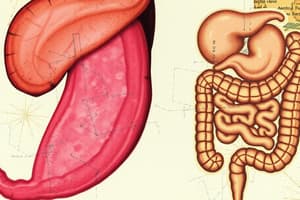Podcast
Questions and Answers
What are the structural components that separate lobules in a parenchyma?
What are the structural components that separate lobules in a parenchyma?
- Septa (correct)
- Fibers
- Neurons
- Vessels
Which of the following is NOT a component of the lobules in a parenchyma?
Which of the following is NOT a component of the lobules in a parenchyma?
- Acini
- Muscle fibers (correct)
- Septa
- Ducts
What is primarily contained within the secretory unit of a lobule?
What is primarily contained within the secretory unit of a lobule?
- Secretory cells (correct)
- Connective tissue
- Adipose cells
- Nerve cells
What is the correct term for the functional units found within lobules?
What is the correct term for the functional units found within lobules?
How are lobules structured in relation to each other within a parenchyma?
How are lobules structured in relation to each other within a parenchyma?
What is the shape of the cells described?
What is the shape of the cells described?
What characteristic is associated with the cytoplasm of the described cells?
What characteristic is associated with the cytoplasm of the described cells?
Which feature indicates the secretory function of the cells?
Which feature indicates the secretory function of the cells?
What do the small lumen and zymogen granules indicate about the cells' function?
What do the small lumen and zymogen granules indicate about the cells' function?
What is implied by the junctional complexes formed by these cells?
What is implied by the junctional complexes formed by these cells?
What are the smallest branches in the intralobular duct system of salivary glands?
What are the smallest branches in the intralobular duct system of salivary glands?
Which component directly empties into the intercalated ducts in the salivary gland?
Which component directly empties into the intercalated ducts in the salivary gland?
In the context of the salivary gland, what is the primary function of intercalated ducts?
In the context of the salivary gland, what is the primary function of intercalated ducts?
Which of the following structures has a larger diameter compared to intercalated ducts?
Which of the following structures has a larger diameter compared to intercalated ducts?
Which structural component is involved in the initial stage of saliva secretion before entering intercalated ducts?
Which structural component is involved in the initial stage of saliva secretion before entering intercalated ducts?
What is a distinguishing feature of the cells described in the content?
What is a distinguishing feature of the cells described in the content?
What type of granules do the apical regions of these cells contain?
What type of granules do the apical regions of these cells contain?
How does the lumen of the described structure compare to other types?
How does the lumen of the described structure compare to other types?
In what organization are these cells typically arranged?
In what organization are these cells typically arranged?
What staining characteristic is associated with the apical granules of these cells?
What staining characteristic is associated with the apical granules of these cells?
What is the primary component that makes up the stroma of the pancreas?
What is the primary component that makes up the stroma of the pancreas?
What role does the connective tissue septa play in the pancreas?
What role does the connective tissue septa play in the pancreas?
Which of the following statements about the histological structure of the pancreas is true?
Which of the following statements about the histological structure of the pancreas is true?
Why is the structural organization of the pancreas important?
Why is the structural organization of the pancreas important?
Which tissue type predominantly forms the capsule of the pancreas?
Which tissue type predominantly forms the capsule of the pancreas?
Flashcards are hidden until you start studying
Study Notes
### Parenchyma Structure
- Composed of lobules
- Lobules are separated by connective tissue septa.
- Lobules form the functional unit of the gland and contain acini (secretory units) and ducts.
### Secretory Unit
- Consists of cells with a pyramidal shape, broad base, and a narrow apical surface
- Cells have a round central nucleus, well-stained rough endoplasmic reticulum, and basophilic cytoplasm.
- Cells are connected by junctional complexes.
- Form a rounded secretory unit called an acinus, with a small lumen
- Apical zymogen granules present for protein secretion
### Intralobular Duct System
- Secretory acini and tubules empty into intercalated ducts.
- Intercalated ducts are the smallest branches with a small diameter
### Pancreas Histological Structure
- Stroma
- A capsule of connective tissue surrounds the pancreas. - Connective tissue septa divide the pancreas into lobules.
Studying That Suits You
Use AI to generate personalized quizzes and flashcards to suit your learning preferences.




